1994 PONTIAC BONNEVILLE brake fluid
[x] Cancel search: brake fluidPage 93 of 290
![PONTIAC BONNEVILLE 1994 Owners Manual Features & Controls
SYSTEMS MONITOR
0
(-J[=zFz]
[HeURlTY][-))
Warning Lights (CONT.)
I
I-] INFORMATION DRIVER
CHECK OIL LEVEL - LAMP
WASHER FLUID
CHECK QAQES LOW
COOLANT
moo DOOR TRUNK PONTIAC BONNEVILLE 1994 Owners Manual Features & Controls
SYSTEMS MONITOR
0
(-J[=zFz]
[HeURlTY][-))
Warning Lights (CONT.)
I
I-] INFORMATION DRIVER
CHECK OIL LEVEL - LAMP
WASHER FLUID
CHECK QAQES LOW
COOLANT
moo DOOR TRUNK](/manual-img/50/58378/w960_58378-92.png)
Features & Controls
SYSTEMS MONITOR
0
(-J[=zFz]
[HeURlTY][-))
Warning Lights (CONT.)
I
I-] INFORMATION DRIVER
CHECK OIL LEVEL - LAMP
WASHER FLUID
CHECK QAQES LOW
COOLANT
moo DOOR TRUNK AJAR TURN SIONAL
BACK UP TAIL
BRAKE LAMP
MILES TRIP
(][TEiir] ENGINE SOON
[E][--
Engine Coolant Temperature Warning
Light
This light tells you that your engine
coolant has overheated or your radiator
cooling fans are not working.
If you have
been operating your vehicle under normal
driving conditions, you
should pull off the
road, stop your vehicle and
turn the
engine off as soon as possible.
I #..92
ProCarManuals.com
Page 164 of 290
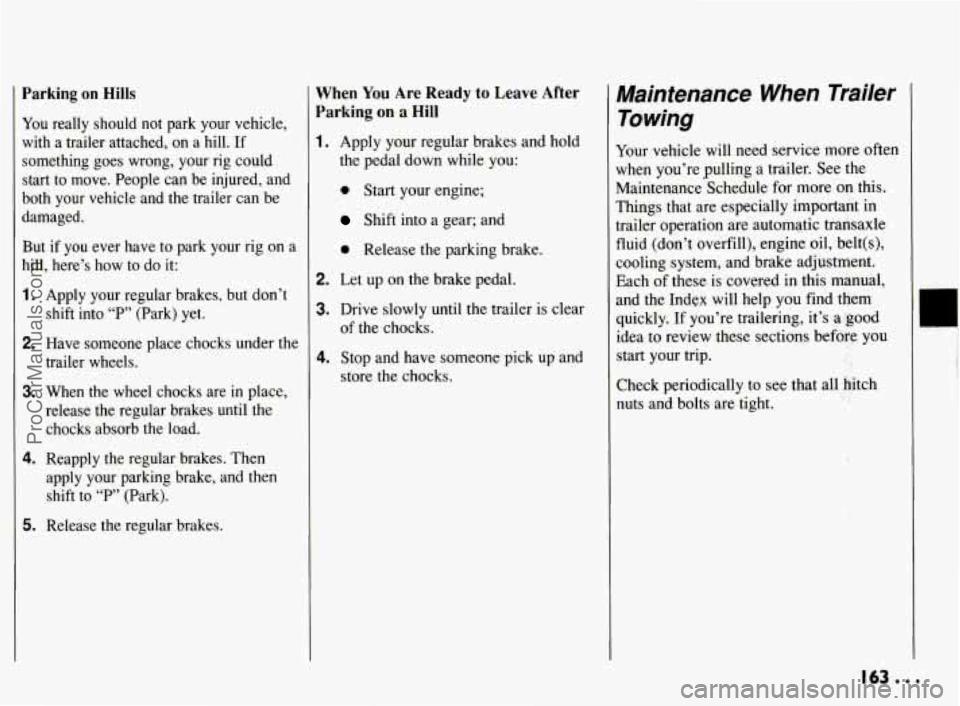
Parking on Hills
You really should not park your vehicle,
with a trailer attached, on a hill.
If
something goes wrong, your rig could
start to move. People can be injured, and
both your vehicle and the trailer can be
damaged.
But if you ever have to park your rig on a
hill, here’s how to do it:
1.
2.
3.
4.
5.
Apply your regular brakes, but don’t
shift into
“P” (Park) yet.
Have someone place chocks under the
trailer wheels.
When the wheel chocks are in place,
release the regular brakes until the chocks absorb the load.
Reapply the regular brakes. Then
apply your parking brake, and then shift to
“F”’ (Park).
Release the regular brakes.
When You Are Ready to Leave After
Parking
on a Hill
1.
2.
3.
4.
Apply your regular brakes and hold
the pedal down while you:
0 Start your engine;
Shift into a gear; and
0 Release the parking brake.
Let up on the brake pedal.
Drive slowly until the trailer is clear
of the chocks.
Stop and have someone pick up and
store the chocks.
Maintenance When Trailer Towing
Your vehicle will need service more often
when you’re pulling a trailer.
See the
Maintenance Schedule for more
on this.
Things that are especially important in
trailer operation are automatic transaxle
fluid (don’t overfill), engine oil, belt(s),
cooling system, and brake adjustment,
Each
of these is covered in this manual,
and the Index will help you find them
quickly. If you’re trailering, it’s a good
idea to review these sections before. you
start your trip.
Check periodically to
see that all hitch
nuts and bolts are tight.
,j.;
i .a
1. i
,
.?.
163...
ProCarManuals.com
Page 202 of 290
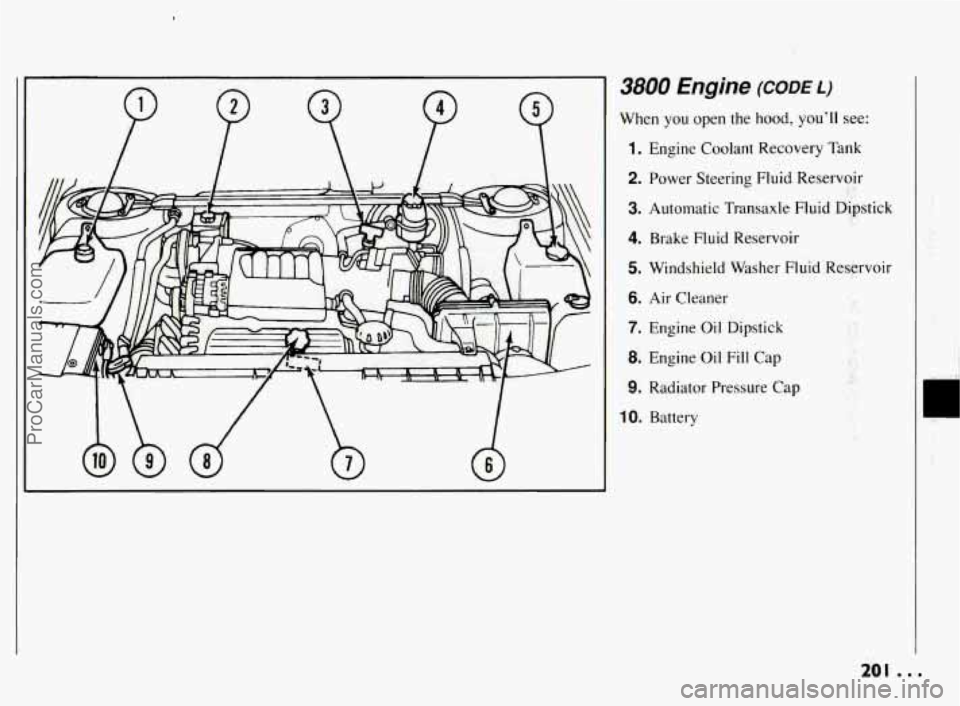
3800 Engine (CODE L)
When you open the hood, you'll see:
1. Engine Coolant Recovery Tank
2. Power Steering Fluid Reservoir
3. Automatic Transaxle Fluid Dipstick
4. Brake Fluid Reservoir
5. Windshield Washer Fluid Reservoir
6. Air Cleaner
7. Engine Oil Dipstick
8. Engine Oil Fill Cap
9. Radiator Pressure Cap
10. Battery I. .. I I 5 ;;$ " :. 1. ,.:.;
201 ..*
ProCarManuals.com
Page 203 of 290
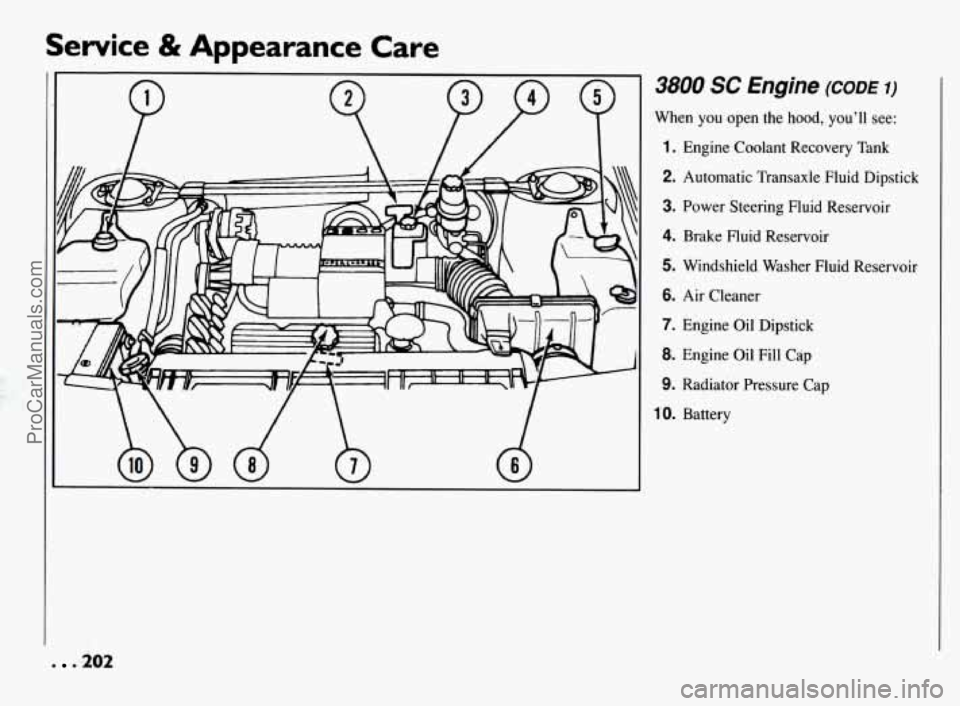
Service & Appearance Care
. 0 202
3800 SC Engine (CODE I)
When you open the hood, you’ll see:
1. Engine Coolant Recovery Tank
2. Automatic Transaxle Fluid Dipstick
3. Power Steering Fluid Reservoir
4. Brake Fluid Reservoir
5. Windshield Washer Fluid Reservoir
6. Air Cleaner
7. Engine Oil Dipstick
8. Engine Oil Fill Cap
9. Radiator Pressure Cap
lo. Battery
ProCarManuals.com
Page 213 of 290
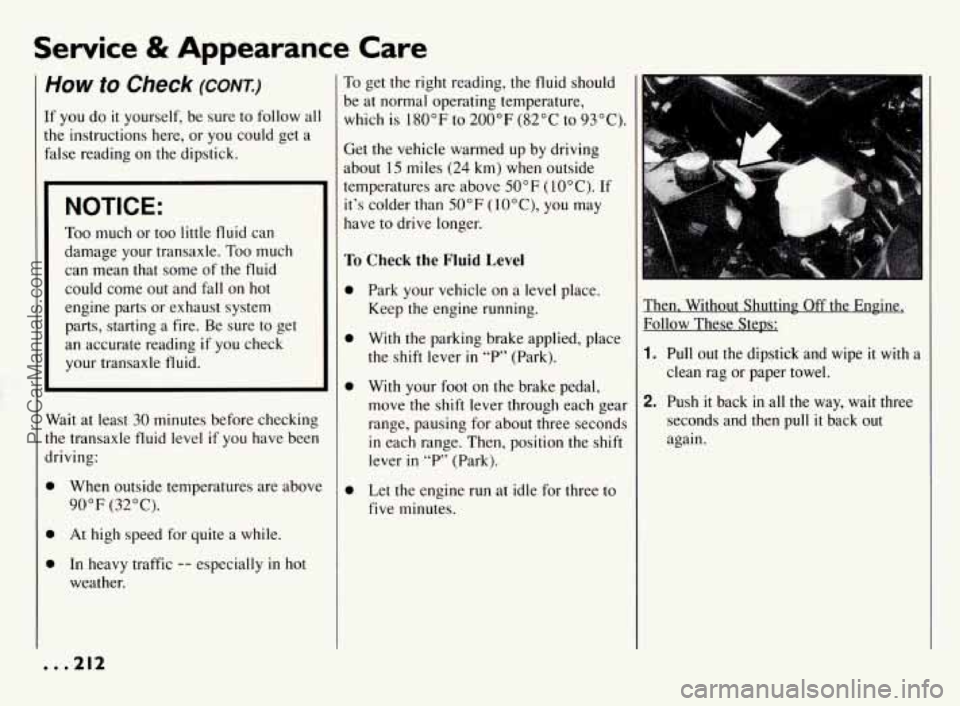
Service & Appearance Care
How to Check (cow.)
If you do it yourself, be sure to follow all
the instructions here, or
you could get a
false reading on the dipstick.
NOTICE:
Too much or too little fluid can
damage your transaxle. Too much
can mean that some of
the fluid
could come out and fall on hot
engine parts or exhaust system
parts, starting a fire. Be sure to get
an accurate reading
if you check
your transaxle
fluid.
Wait at least 30 minutes before checking
the transaxle fluid
level if you have been
driving:
0 When outside temperatures are above
90°F (32°C).
0 At high speed for quite a while.
0 In heavy traffic -- especially in hot
weather.
I
To get the right reading, the fluid should
be at normal operating temperature,
which is 180°F to 200°F (82°C to 93°C).
Get the vehicle warmed up by driving
about 15 miles (24 km) when outside
temperatures are above 50°F (10°C). If
it's colder than 50°F ( 10°C), you may
have
to drive longer.
To Check the Fluid Level
Park your vehicle on a level place.
Keep the engine running.
With the parking brake applied, place
the shift lever
in "P" (Park).
With your
foot on the brake pedal,
move the shift lever through each gear
range, pausing for about three seconds
in each range. Then, position the shift
lever
in "P" (Park).
Let the engine run at idle for three
to
five minutes. Then. Without Shutting
Off the Engine,
Follow These Steps:
1. Pull out the dipstick and wipe it with a
clean rag or paper towel.
2. Push it back in all the way, wait three
seconds and then pull it back
out
again.
ProCarManuals.com
Page 218 of 290
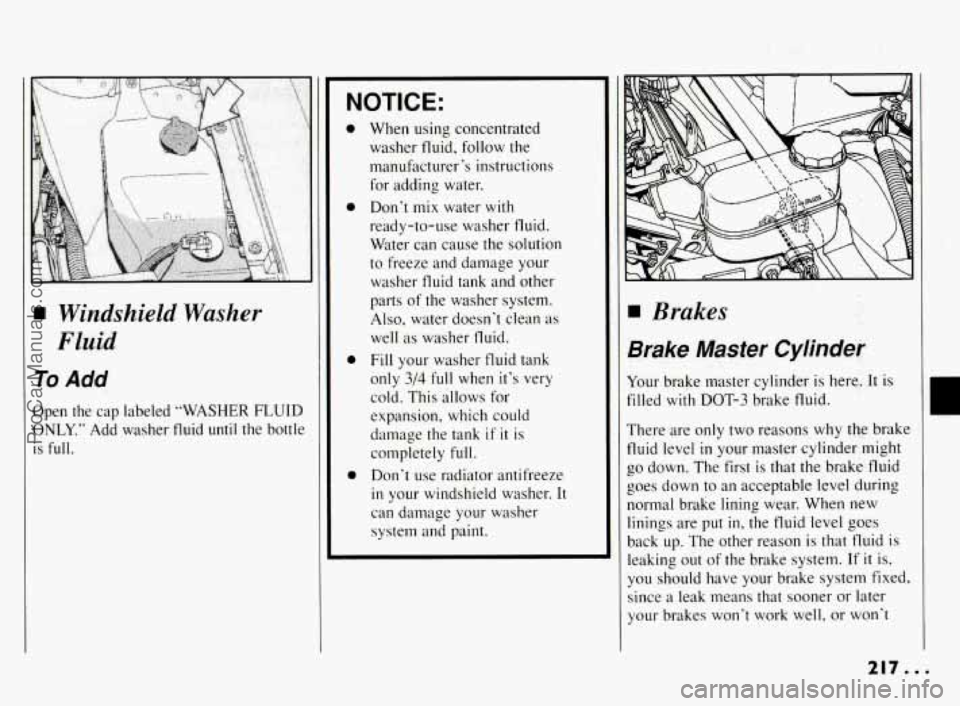
Windshield Washer
Fluid
To Add
Open the cap labeled “WASHER FLUID
ONLY.” Add washer fluid
until the bottle
is full.
NOTICE:
0
0
0
0
When using concentrated washer fluid, follow the
manufacturer’s instructions
for adding water.
Don’t mix water with
ready-to-use washer fluid.
Water can cause the solution
to freeze and damage
your
washer fluid tank and other
parts
of the washer system.
Also, water doesn’t clean as
well as washer fluid.
Fill your washer fluid tank
only
3/4 full when it’s very
cold. This allows for
expansion, which could
damage the tank
if it is
completely full.
Don’t use radiator antifreeze
in your windshield washer. It
can damage your washer
system and paint.
Brakes
Brake Master Cylinder
Your brake master cylinder is here.
filled with DOT-3 brake fluid. It is
There are only two reasons why the brake
fluid level
in your master cylinder might
go down. The first is that the brake fluid
goes down to an acceptable level during
normal
brake lining wear. When new
linings are put
in, the fluid level goes
back up. The other reason is that fluid is
leaking out of the brake system. If
it is,
you should have your brake system fixed,
since a leak means that sooner
or later
your brakes won’t work well, or won’t
217...
ProCarManuals.com
Page 219 of 290
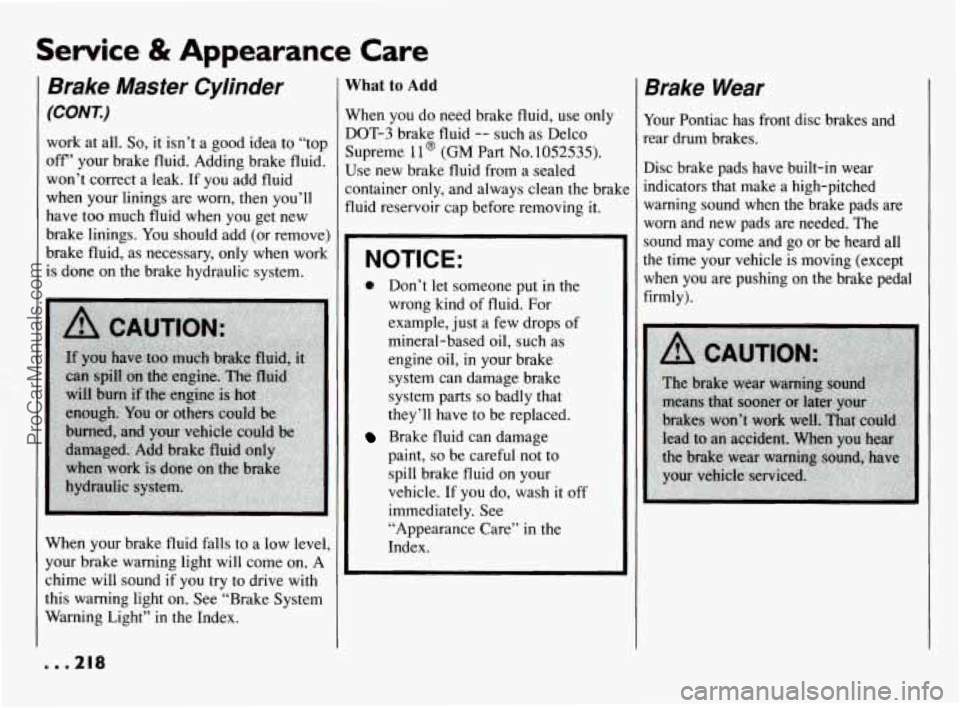
Service & Appearance Care
Brake Master Cylinder
(CONK)
work at all. So, it isn’t a good idea to “top
off’ your brake fluid. Adding brake fluid.
won’t correct a leak. If you add fluid
when your linings are worn, then you’ll
have too much fluid when you get new
brake linings.
You should add (or remove)
brake fluid, as necessary, only when work
is done on the brake hydraulic system.
When your brake fluid falls to a low level,
your brake warning light will come on. A
chime will sound
if you try to drive with
this warning light on. See “Brake System
Warning Light” in the Index.
. . .218
What to Add
When you do need brake fluid, use only
DOT-3 brake fluid
-- such as Delco
Supreme 11
@ (GM Part No. 1052535).
Use new brake fluid from a sealed
container only, and always clean the brake
fluid reservoir cap before removing
it.
NOTICE:
e Don’t let someone put in the
wrong kind of fluid. For
example, just a few drops of
mineral-based oil, such as
engine oil, in your brake
system can damage brake
system parts
so badly that
they’ll have to be replaced.
Brake fluid can damage
paint,
so be careful not to
spill brake fluid on your
vehicle. If you do, wash it
off
immediately. See
“Appearance Care”
in the
Index.
Brake Wear
Your Pontiac has front disc brakes and
rear drum brakes.
Disc brake pads have built-in wear
indicators that make a high-pitched
warning sound when the brake pads are
worn and new pads are needed. The
sound may come and
go or be heard all
the time your vehicle is moving (except when you are pushing on the brake pedal
firmly).
ProCarManuals.com
Page 255 of 290
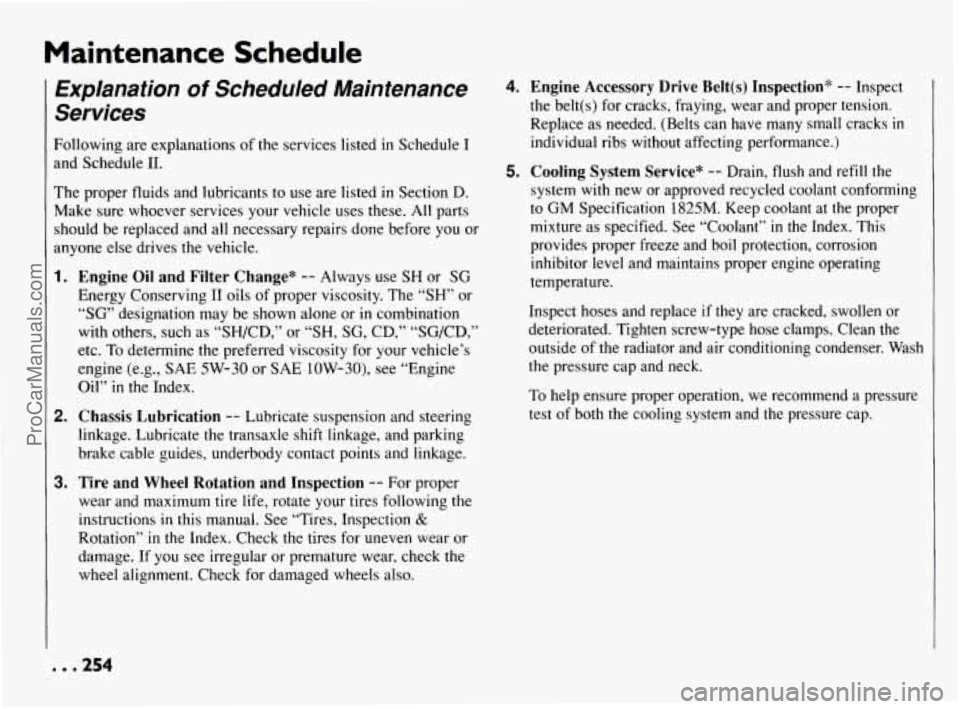
Maintenance Schedule
Explanation of Scheduled Maintenance
Services
Following are explanations of the services listed in Schedule I
and Schedule
11.
The proper fluids and lubricants to use are listed in Section D.
Make sure whoever services your vehicle uses these. All parts
should be replaced and all necessary repairs done before you or
anyone else drives the vehicle.
1. Engine Oil and Filter Change* -- Always use SH or SG
Energy Conserving I1 oils
of proper viscosity. The “SH” or
“SG” designation may be shown alone or in combination
with others, such as “SH/CD,” or “SH, SG, CD,” “SG/CD,”
etc. To determine the preferred viscosity for your vehicle’s
engine (e.g., SAE 5W-30 or SAE
10W-30), see “Engine
Oil”
in the Index.
2. Chassis Lubrication -- Lubricate suspension and steering
linkage. Lubricate the transaxle shift linkage, and parking
brake cable guides, underbody contact points and linkage.
3. Tire and Wheel Rotation and Inspection -- For proper
wear and maximum tire
life, rotate your tires following the
instructions in this manual. See “Tires, Inspection &
Rotation” in the Index. Check the tires for uneven wear or
damage. If
you see irregular or premature wear, check the
wheel alignment. Check for damaged wheels also.
4. Engine Accessory Drive Belt(s) Inspection* -- Inspect
the belt(s) for cracks, fraying, wear and proper tension.
Replace as needed. (Belts can have many small cracks
in
individual ribs without affecting performance.)
5. Cooling System Service* -- Drain, flush and refill the
system with new or approved recycled coolant conforming
to GM Specification 1825M. Keep coolant at the proper
mixture as specified. See “Coolant”
in the Index. This
provides proper freeze and boil protection, corrosion inhibitor level and maintains proper engine operating
temperature.
Inspect hoses and replace
if they are cracked, swollen or
deteriorated. Tighten screw-type hose clamps. Clean the
outside of the radiator and air conditioning condenser. Wash
the pressure cap and neck.
To help ensure proper operation, we recommend a pressure
test of both the cooling system and the pressure cap.
ProCarManuals.com